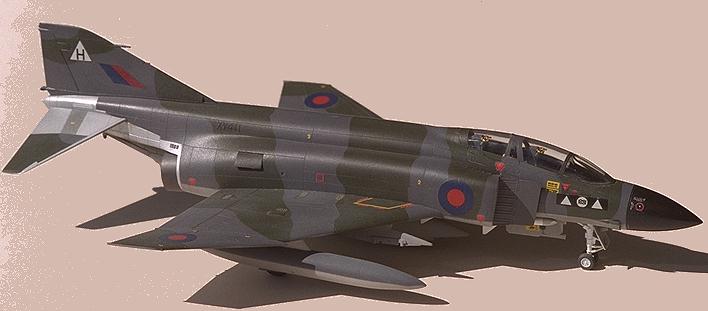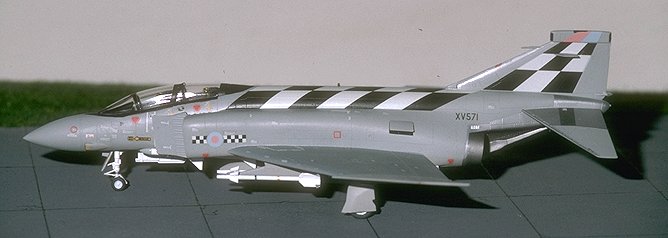
Fujimi 1/72 F-4K, M, FG.1, FGR.2 Phantom II
|
KIT # |
H- 6,7,8,9, and others |
|
PRICE: |
@ $20.00 |
|
DECALS: |
See writeup for details |
|
REVIEW: |
|
|
NOTES: |

|
HISTORY |
Just to give a brief rundown on the aircraft. The Phantom II, as you may well know, is the most successful post war American aircraft ever built, with numbers world-wide topping 5,000 examples. First flown in 1958, examples are still in service with Japan, South Korea, Egypt, Israel, Turkey, Greece, Spain and Germany. Soon after the F-4J was brought into service around the early 1960's the British decided that they needed the aircraft for the Royal Navy. However, it had to have certain distinctly British components, the biggest of which was the RR Spey engine. Since it is larger than the J-79, a redesign was needed. To make a long story short, what the British got was a larger, heavier, more powerful and eventually slower F-4, mostly because of the larger intake required. While it is decidedly faster in acceleration and at low level, it just could not match the ultimate speed of the US Phantoms.
Once the Royal Navy got their F-4s, the RAF decided it needed them as well. The initial designation for the RN Phantoms was F-4K, with F-4M being the RAF version. Later this was changed to FG.1 and FGR.2 respectively. Unlike USN F-4J's, which the K and M are broadly based upon, the British versions have the capability of being flown from the back seat. All that has to be done is to have the control stick and rudder pedals installed. Many, including myself, think that the British Phantom is one of the neatest looking of the various subtypes.

|
THE KIT |
Fujimi's British Phantoms first appeared around 1987 . Today, they are still the best of all the Fujimi F-4s and the best British Phantoms available in 1/72. It is exquisitely detailed with recessed panel lines that actually match from one side of a part to the next. Included is a very nice cockpit with plenty of detail for the scale. The instrument and console panels include raised detail as well as decals. In addition, each kit comes with a full selection of drop tanks and a nice ordnance selection. Some of the kits even include the recce pod to do a 2 or 41 Sq aircraft. Also included in each kit is a superb decal sheet. Now typical of Japanese kits of the time, the red is a bit too bright for my tastes, but a full stencil suite is included as are markings for a number of squadrons.

|
CONSTRUCTION |
This is where I get to say very little about the kit. The only part of the kit where any filler and fitting needs to be done are the intakes, a common problem area on almost all Phantom kits. On the several I have built, the area where the wing underside meets the area aft of the intakes has needed filler. You also need to do some shaping of the small nose intakes that bring in cooling air to the avionics on either side of the aircraft. Another area that can cause some fit problems is the aft portion of the wing on the sides. However careful building will often negate any troubles in this section.
|
CONCLUSIONS |
The rest of the kit really goes together very well indeed, and can be built into a super representation of the British Phantom.
Should you decide not to use the kit markings, there are a number of very good sheets covering all of the RAF and RN units that flew the aircraft. Probably the finest around, in both quality and research are those by Modeldecal. All of the F-4s used to illustrate this article have been built straight from the box using Modeldecal sheets.